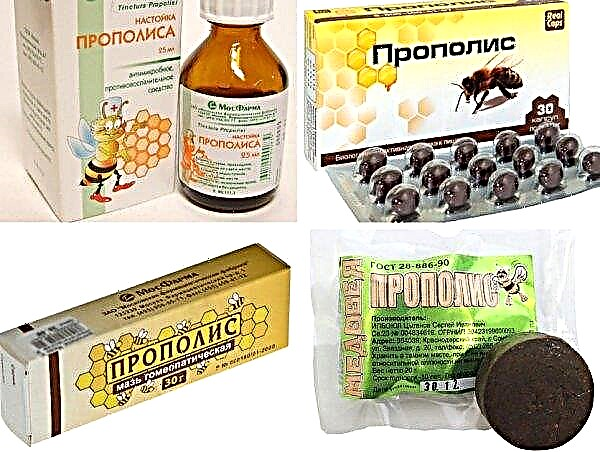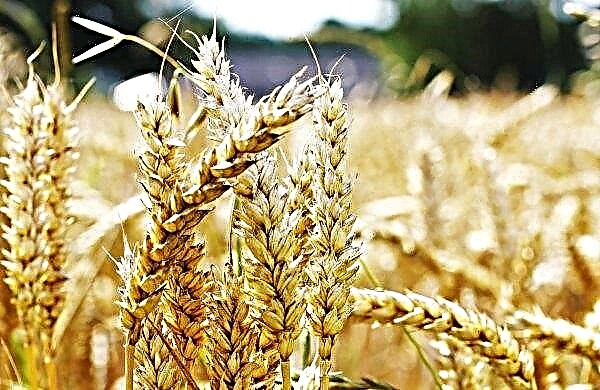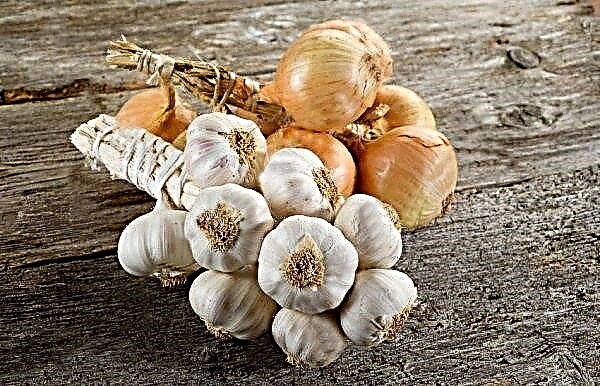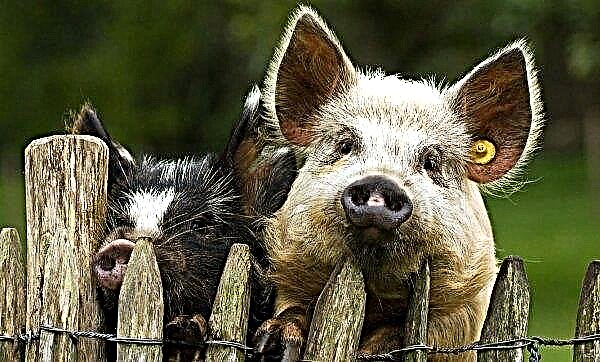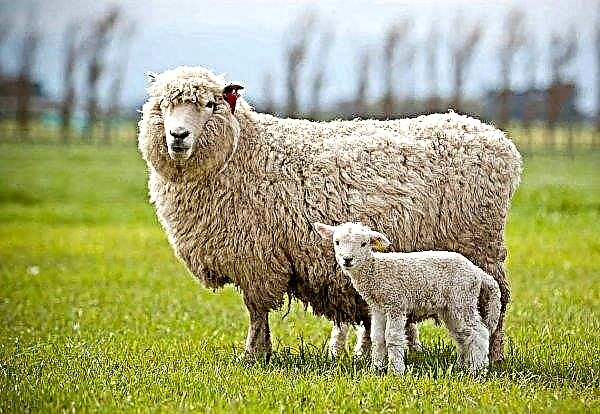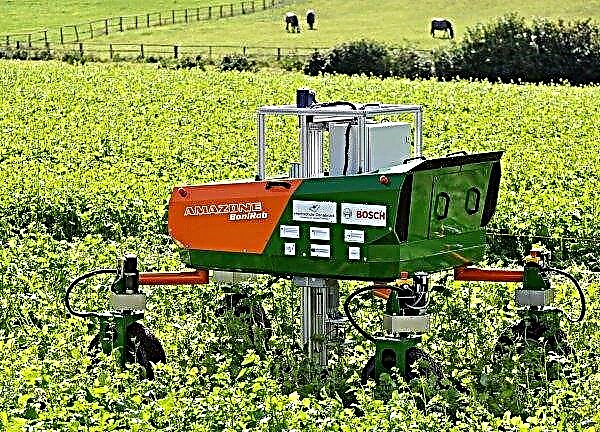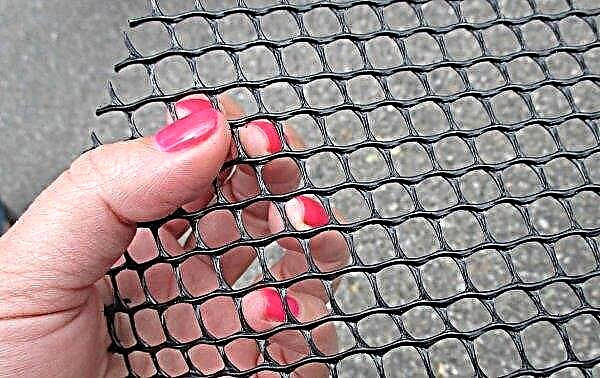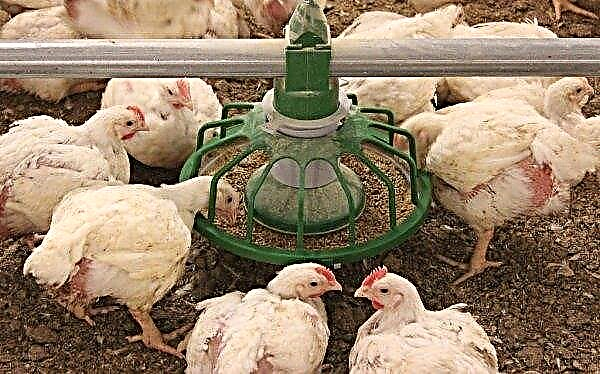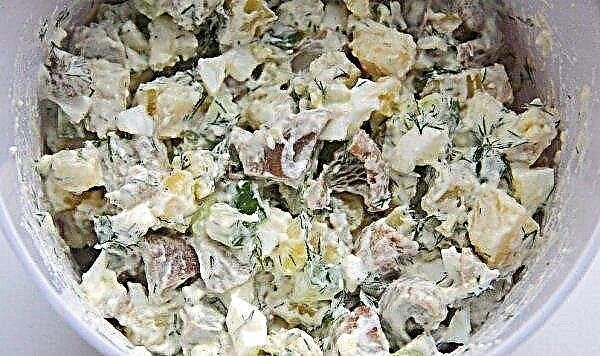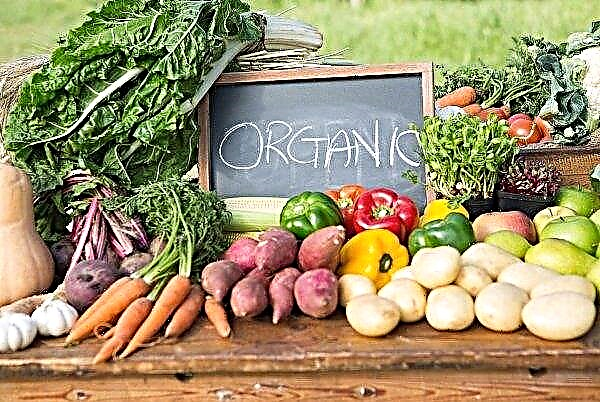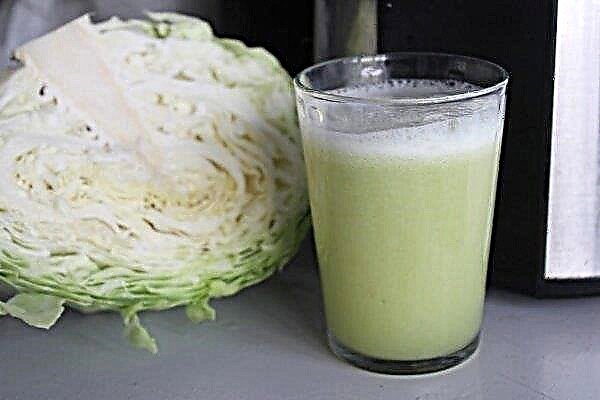A gift to Stepanov is a new kind of sweet cherry, which appeared due to the selection work of the Bryansk Research Institute and was registered in the State Register in 2015. Consider the main characteristics of the variety, especially the cultivation and care on the plot.
Description and characteristics of the variety
Sweet cherry Present to Stepanov belongs to the varieties of medium-late ripening and is zoned in the Central region.
Did you know? According to the records of the historian Pliny, the birthplace of cherries is Turkey, the city of Giresun, and the Roman commander Lucullus brought the berry to Europe in 680 BC. e.
Tree description
A tree of the aforementioned variety is characterized by medium growth strength - the plant usually does not exceed 3 m in height, but sometimes it can grow up to 5 m. The trunk is flat, with straight, thickened shoots with a dense bark, which acquires an olive hue at the edges of the branches. With the onset of autumn, the bark changes color and becomes silvery. The crown of the tree has a pyramidal shape, the upper tier of branches grows very quickly. It is densely strewn with dull green large oval leaves, the edges of which have small notches. The variety blooms in white, medium-sized flowers, collected in 3 pieces in one inflorescence. The variety blooms in white, medium-sized flowers, collected in 3 pieces in one inflorescence.
The variety blooms in white, medium-sized flowers, collected in 3 pieces in one inflorescence.
Fruit Description
Cherry Berries Present to Stepanov - medium in size, have a heart-shaped rounded shape. Fruit - glossy, rich dark red tones, less often - with a purple tint. Juicy, crisp, blood-red flesh is covered with a dense, but quite thin skin. Each berry weighs, on average, 5–7 g, which corresponds to the usual weight of dessert cherries. The stone inside the berry is small, round, well separated from the pulp.
Frost resistance
Variety of cherries Gift Stepanov well tolerates low temperaturesTherefore, it is often chosen for cultivation in the cold northern regions, in the Urals and in Siberia. An adult tree is able to winter without loss at temperatures up to –35 ° C, but provided that the trunk is covered, which is the “weak point” of the tree and can freeze in severe frosts. Young seedlings hibernate worse, but if they provide good shelter, they will also tolerate frosty winters. Young seedlings hibernate worse, but if they provide good shelter, they will also tolerate frosty winters.
Young seedlings hibernate worse, but if they provide good shelter, they will also tolerate frosty winters.
Productivity
Grade - high-yielding, therefore, from an adult tree, when grown in a summer cottage, you can collect about 60 kg of fruits per season. On an industrial scale, they achieve even greater productivity - up to 85 centners per 1 hectare of plantings. The beginning of fruiting in the tree falls 4-5 years after planting. A fruit bearing plant will produce a crop every year, increasing the number of harvested fruits. A fruit bearing plant will produce a crop every year, increasing the number of harvested fruits.
A fruit bearing plant will produce a crop every year, increasing the number of harvested fruits.
Pollinators
A gift to Stepanov is a self-infertile variety, therefore, he will bear fruit on the site only if there are neighboring pollinating trees.
Consider which variety is better to choose for planting in the garden, near the sweet cherry Gift to Stepanov, to guarantee a plentiful harvest:Important! Not all sweet cherry varieties will be good pollinators for the Gift to Stepanov, since they differ in flowering terms.
- Teremoshka - blooms in mid-May, the fruiting period begins in late July;
- Beloved Astakhov - the flowering period falls in mid-May, the fruits are ready for harvest in mid-summer;
- Bryansk pink - flowering occurs at the end of May, the harvest occurs at the end of July.
Advantages and disadvantages
- Sweet cherry Present to Stepanov has a large number of advantages, which are presented:
- increased level of resistance to changes in weather conditions;
- high winter hardiness and drought tolerance;
- stable productivity;
- the universality of the use of fruits;
- increased immunity to common diseases of fruit trees.
- However, the variety has several disadvantages, among which it is worth highlighting:
- self-fertility and the need to place the tree next to pollinating varieties;
- late fruiting period - 4-5 years after planting;
- small size and weight of the fruit.
Features of planting seedlings
In order to grow a healthy fruitful tree, it is necessary to choose the right seedling and plant it, observing the basic subtleties of the procedure and taking into account the recommended scheme.
Primarily, choose the appropriate period for planting a young seedling: if the region is southern, then the best time for planting in open ground is autumn, if Central or Northern - planting is done exclusively in spring. Autumn planting is good because by spring the young tree will already be strong enough and begin to actively grow fruit branches, but spring planting allows the tree to grow a strong root system and not die from severe frosts in colder regions.
When choosing a place for planting a seedling, they pay attention to the fact that the territory is well-lit, not flooded in the early spring during the thaw, and in the season of heavy rains, water did not accumulate in the near-stem circle. If groundwater in a summer cottage approaches high to the surface of the soil layer, it is recommended that the cherry be planted on a hill. Loam or sandy loam with good aeration and water permeability are considered the best soil for cultivation.
Correctly selected high-quality planting material is half the success when growing any plant, therefore, we will consider how to choose a suitable seedling in a store or nursery. In order for the young tree to quickly take up and grow well, choose a seedling according to the following recommendations:Important! It is not recommended to plant a tree next to currant bushes, a pear and an apple tree - cherries grow poorly and bear fruit in the vicinity of these plants.
- seedling 1-2 years of age;
- has up to 5 root processes;
- height - from 1.5 to 2 m;
- on the trunk there is a trace of vaccination and only one conductor;
- the root system is healthy, without mechanical damage, traces of diseases and vital activity of pests.

Consider the technology of planting cherries in the garden:
- Planting a seedling should be carried out in a pre-prepared hole, dimensions: 60 cm in depth, 80 cm in width.
- Humus (1 bucket) and ash (200 g) are mixed into the pit bottom, mixed with 1/3 of the fertile soil layer.
- Before planting, the roots of the tree are immersed for 2 hours in water so that they are well nourished and do not experience a lack of moisture at first.
- A wooden stake, at least 1.5 m high, is driven into the bottom of the pit, which will serve as a support for the young plant.
- The root system of cherries is placed in the pit, straightening the roots in different directions, carefully so as not to damage them.
- Sprinkle the rhizome, filling 2/3 of the pit with fertile soil, tamp a little, then fill the remaining free space of the pit with the top layer of excavated soil. They make sure that the root neck of the plant protrudes 4-5 cm above the surface.
- Lightly tamp the trunk circle, tie the trunk to the support with a soft natural cloth.
- 20 l of water is irrigated in the near-stem circle, so that the moisture “condenses” the loose areas and minimizes the possibility of soil subsidence.
Subtleties of further care
After planting, at first, special care for the tree is not required, especially if the planting was carried out in the fall. In the future, it is necessary to carry out certain procedures in order to maintain the plant in good condition and contribute to high productivity.
Watering
Watering the tree is recommended regularly for normal flowering and fruit formation.. The norm is the introduction of water into the trunk circle 1 time per month, teaching watering up to 1 time in 2 weeks during hot summer weather. The amount of fluid used is 20-50 l, depending on the age of the tree.
After watering, the soil should be well loosened and sprinkled with mulch so that the moisture is retained longer. In addition, mulch helps protect the plant from weeds, which greatly depletes the soil and interferes with the normal nutrition of the roots.
Important! Watering is completely stopped 2 weeks before the harvest - if this is not done, the fruits will crack and will be poorly stored.
Soil fertilizer
Fertilizer application - An important point that you should not forget about if you want to maintain yield at a high level. The introduction of additional nutrients into the soil begins the next year after planting, since the first time the tree has enough fertilizers that are applied to the soil during planting.

In the first three years, before fruiting, the tree is fed a urea solution. From May to June, a solution is applied to the soil - 30 g of urea per 10 liters of water, the stem circle is watered with one liter of nutrient. In the fourth year of cultivation, the tree is fed 2 times - in spring and autumn. In the spring, urea (150 g) per 1 m² is added to the soil for digging, and in the fall, superphosphate (300 g) and potassium sulfate (100 g) per 1 plant. In the future, each year, a urea solution (200 g per 10 l of water) is added to the soil in the spring. In autumn, it should be fertilized with a solution of ammofoski (30 g per 10 liters of water) under one plant.
Pruning
Tree pruning is carried out immediately after spring planting, removing the top of the tree, leaving a trunk length of 80 cm. After autumn planting, such pruning is not carried out, but is postponed until spring, so that the tree does not die from the resulting stress during early frosts. In spring, pruning is done before the sap flow and the awakening of the kidneys - in mid-March - early April, depending on the region of cultivation. In the second year, in spring, they begin to form the first tier of the crown; for this, they leave up to 4 of the strongest and most well developed lower branches, shorten them to a length of 30 cm, remove the remaining shoots, and also shorten the central conductor by measuring 1 m from the growth point of the lower branch. For pruning the tree, clean and well-sharpened tools are used so as not to severely injure the tree. Slices more than 2 cm in diameter are covered with garden varieties to protect the plant from the penetration of bacteria and viruses through the wound.
For pruning the tree, clean and well-sharpened tools are used so as not to severely injure the tree. Slices more than 2 cm in diameter are covered with garden varieties to protect the plant from the penetration of bacteria and viruses through the wound.
In the third year make the laying of the second tier of the crown, leaving up to 3 branches, removing all the weak and sick. All remaining branches are shortened by 20 cm, the central conductor is cut off, measuring 1 m from the growth point of the branches of the second tier. For 4 years, the cherry enters fruiting, therefore, forming pruning is not carried out, and the tree is sanitized, removing all diseased, dry branches, small shoots and shoots growing inside the crown.
Pest and Disease Control
Despite the high resistance to common diseases, cherries of the described variety can affect:
- moniliosis - a fungal disease that provokes the drying of flowers, shedding of the ovary, curling of leaves, decay and drying of the fruit during the ripening period. For the treatment of the disease, the drugs “Sentinel”, “Chorus” are used, according to the instructions;
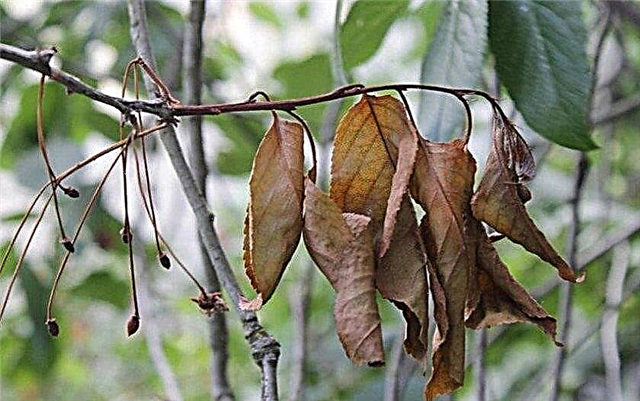
- coccomycosis - fungal disease, which causes the appearance of multi-colored spots and dots on the leaves, in rainy weather, the affected foliage rots and falls. Plant death can be prevented by timely treatment with Horus, Topaz, taking into account the recommendations on the use of drugs;
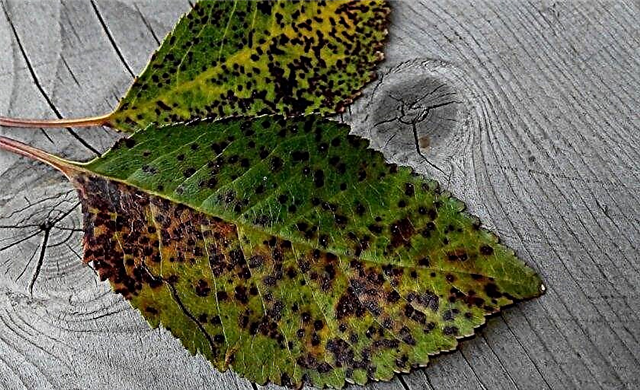
- powdery mildew - provoked by fungal strains that affect leaves and shoots. Sick parts of the plant become covered with white coating and soon die. For the treatment of plants used "Strobi", "Topaz" according to the instructions for the preparations;

- bacteriosis - A bacterial disease called sweet cherry cancer. Watery dark spots appear on the shoots, the stalks are covered with ulcers. Drugs that could cure this disease have not yet been invented, therefore, in order to prevent cancer, the cherries are regularly fed with nitrogenous fertilizers and adhere to the irrigation regimen.
Among the common pests of cherries are:
- black cherry aphids - small insects that settle on the back of the leaves, feed on plant juices, lead to massive leaf fall, the tree stops growing, does not bear fruit well. To combat the pest use the drug "Call", according to the instructions on the package;
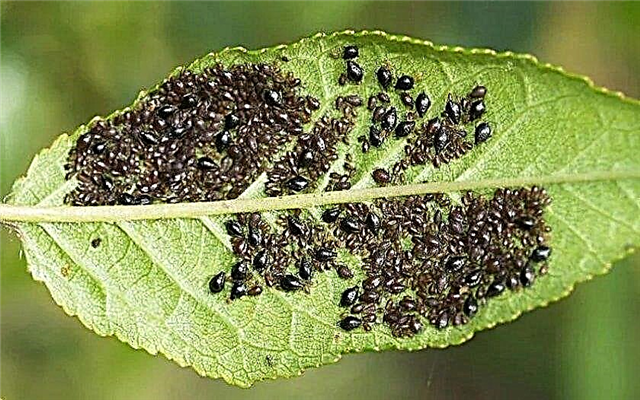
- cherry fly - an insect that can infect up to 90% of the cherry fruit. The fly lays eggs in berries, which quickly turn into larvae and eat the fruit from the inside. Affected fruits quickly rot, become unusable. For the fight, glue traps are used, hung on the plant, when more than 5 insects appear on the traps overnight, it is necessary to spray the cherries with the Calypso, Fufanon or Operkot preparations according to the instructions;
- leaflet - caterpillars of the leafworm are capable of exerting a negative effect on the buds, leaves, buds of the plant, reducing yield and weakening the immunity of the tree. It is necessary to deal with leafworms by treating the plant with Nurell D, Actofit, Ulicid, according to the instructions.
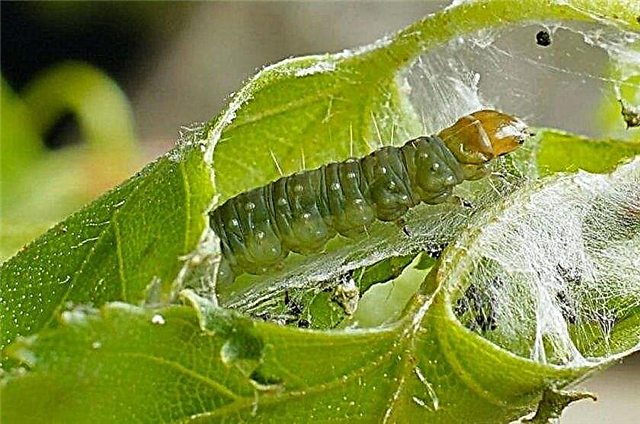

Harvesting and storage
It is necessary to collect cherries in the stage of technical maturity for longer storage. Variety Gift Stepanova ripens in late July - at this time and harvest. Cherry is collected without necessarily separating the berries from the stalk - thus significantly extending the shelf life. It is necessary to pick cherries from a tree carefully, you cannot take berries with your fingers, so as not to pin down, otherwise the process of decay will begin. It is necessary to pick cherries from a tree carefully, you cannot take berries with your fingers, so as not to pin down, otherwise the process of decay will begin.
It is necessary to pick cherries from a tree carefully, you cannot take berries with your fingers, so as not to pin down, otherwise the process of decay will begin.
When picking berries, they are immediately placed in fruit boxes in which storage will be carried out. Duration of storage while providing cherries with ideal conditions is from 2 weeks to 1 month. Berries should be stored in industrial refrigerators (rooms) or domestic refrigerators, setting the temperature at + 1 ... + 2 ° C, maintaining air humidity at 70–80%.
Did you know? To choose a delicious sweet cherry in the store, pay attention to the stalks - fresh, timely-picked berries, stalks are elastic, saturated green. Avoid buying berries with dry, brittle and gray stalks - they have been plucked for a long time and in an overripe state.
Thus, it is not difficult to grow the cherries of the Variety Podarok Stepanov;






